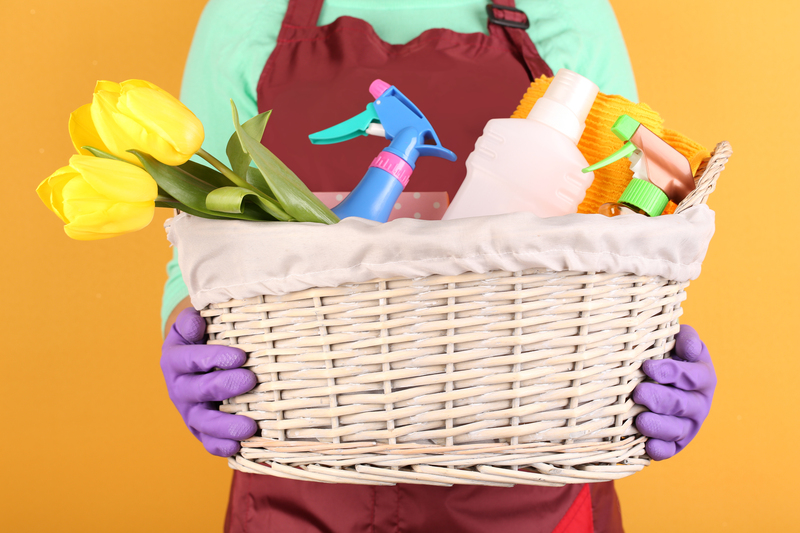Simple Techniques for a Mold-Free Bathroom Routine
Posted on 02/09/2025
Simple Techniques for a Mold-Free Bathroom Routine
A mold-free bathroom isn't just about pleasant aesthetics; it's vital to protect your family's health and the longevity of your home. Bathrooms are high-humidity areas, prone to moisture accumulation, making them a perfect breeding ground for mold and mildew. Fortunately, with the right routine and habits, you can effectively prevent mold growth, ensuring a fresher, cleaner, and healthier bathroom environment. In this comprehensive guide, we'll share simple techniques for a mold-free bathroom routine that you can easily integrate into your daily and weekly schedule.

Why is Bathroom Mold Prevention Important?
Mold is not just unsightly--it can also trigger allergies, asthma attacks, and other health problems, especially in sensitive groups like children, the elderly, and individuals with compromised immune systems. Additionally, mold can damage grout, sealant, and even structural elements in your bathroom. That's why learning effective mold prevention techniques is essential for every homeowner and renter.
Understanding What Causes Mold in Bathrooms
- Humidity: Steamy showers and insufficient ventilation elevate moisture levels, setting the stage for mold.
- Poor Air Circulation: Small or windowless bathrooms struggle to air out, trapping dampness inside.
- Leaky Fixtures: Constant drips from pipes or faucets create persistently damp areas.
- Neglected Cleaning: Accumulated soap scum, skin cells, and organic debris provide food sources for mold spores.
- Condensation: Cold bathroom surfaces attract moisture, especially after hot showers or baths.
When these factors combine, mold can begin to grow within 24-48 hours on tile grout, ceilings, walls, and silicone seals. The key to keeping your bathroom mold-free is to address these issues before they become problematic.
Essential Daily Habits for a Mold-Free Bathroom
Maximize Ventilation
- Use an Exhaust Fan: Always switch on the vent fan during and after showers or baths for at least 20 minutes. This helps expel moist air from the room.
- Open Windows and Doors: If your bathroom has a window, open it after bathing to allow fresh air circulation. Leave the bathroom door open post-shower to dissipate humidity.
- Wipe Down Surfaces: Invest less than a minute to squeegee water off shower walls, glass doors, and tiles after use. Drying surfaces reduces moisture where mold spores tend to land and settle.
Limit Moisture Buildup
- Hang Towels Immediately: Wet towels are mold magnets. Always hang them to dry fully between uses. Replace and launder regularly.
- Keep Shower Curtains Open: After bathing, spread out the curtain or shower liner so it dries swiftly and evenly.
- Empty Bathroom Bins: Trash cans can trap moisture. Empty and disinfect them often to avoid hidden mold growth.
Address Spills and Leaks Right Away
- Fix Drips and Leaks Promptly: Inspect under sinks, around toilets, and at the base of showers for leaks. A leaking faucet or running toilet can keep an area damp 24/7.
- Mop Up Puddles: Never leave standing water on tiles or countertops after use, as even small pools can contribute to mold.
Weekly & Deep-Clean Mold Prevention Routines
Regular Cleaning: The Foundation of a Mold-Free Bathroom
Consistent weekly cleaning prevents both visible mold and hidden spores from taking hold. Here's a simple checklist to integrate into your cleaning schedule:
- Scrub Grout & Tile: Use a bathroom-safe antibacterial cleaner or a vinegar solution to clean grout lines and tiles, paying extra attention to corners and crevices.
- Clean Shower Curtains/Liners: Many curtains and liners are machine washable. Wash or replace them regularly to disrupt any mold spores in their tracks.
- Disinfect High-Touch Surfaces: Wipe faucets, handles, switches, and other frequently contacted surfaces with a disinfectant or natural mold-busting solution.
- Wash Bath Mats: Fabric mats should be laundered weekly and dried thoroughly. Opt for fast-drying rugs if possible.
- Wipe Down Mirrors & Glass: Prevent a film of moisture from accumulating on mirrors and glass doors, discouraging mold growth on these surfaces.
Natural Mold Prevention Solutions
- White Vinegar Spray: Fill a spray bottle with undiluted white vinegar and spritz onto tiles, grout, and shower walls to hinder mold development. Leave for one hour, then rinse with water.
- Baking Soda Paste: Mix baking soda with a little water to create a gentle scrub. Apply to troublesome spots, leave for 15 minutes, scrub, and rinse.
- Tea Tree Oil: Add 1 teaspoon of 100% tea tree oil to 1 cup water in a spray bottle. Mist on problem areas; the natural antifungal properties help deter mold.
- Lemon Juice: Not only does lemon smell fresh, but its acidity helps control mold and brighten tiles and grout. Rub onto grimy spots, let sit, then wipe away.
Tip: Always test natural solutions on a small, inconspicuous area before applying to large sections, especially on colored tiles or delicate surfaces.
Monthly: Deeper Mold-Prevention Tactics
- Inspect Hidden Areas: Check under sinks, behind toilets, and around window frames and exhaust vents for signs of moisture or mold.
- Deep Clean Caulking and Seals: Use an old toothbrush and a baking soda paste or vinegar spray on silicone seams and around tubs where mold loves to hide.
- Check and Replace Grout and Caulk: Discolored, cracked, or peeling caulk and grout allow water to seep behind tiles. Reseal or replace as needed for a watertight finish.
- Wash Shower Heads and Faucets: Remove mineral buildup by soaking components in vinegar for an hour, scrubbing, and rinsing thoroughly.
Smart Upgrades and Tools for a Mold-Free Bathroom
Invest in Mold-Resistant Fixtures
- Mold-Resistant Paint: Choose paints formulated for bathrooms, with built-in mildewcides and water resistance.
- Mold-Proof Caulk and Grout: When renovating, select products labeled mold- and mildew-resistant for tiles and edges.
- Quick-Dry Shower Mats: Bamboo or quick-dry microfiber mats don't retain water like thick cotton rugs, discouraging mildew.
Useful Gadgets to Reduce Bathroom Humidity
- Dehumidifier: Place a small bathroom dehumidifier in areas without adequate ventilation or where condensation is an ongoing problem.
- Humidity Monitor: Also called a hygrometer, this handy device tracks moisture levels and cues you when to ventilate or dry out the space.
- Smart Exhaust Fans: Upgrade to a humidity-sensing exhaust fan that turns on automatically when moisture rises, ensuring you never forget to ventilate.
Spotting and Treating Mold Early
Despite even the most diligent routine, you may sometimes spot small patches of bathroom mold. The key is prompt action. Don't ignore or simply paint over mold--it will return if the underlying moisture problem isn't addressed.
How to Remove Small Mold Spots
- Protect Yourself: Wear gloves, goggles, and a mask to avoid inhaling spores.
- Spray with Cleaner: Use a bathroom-safe mold remover, white vinegar, or hydrogen peroxide directly on affected areas.
- Let It Sit: Allow the solution to work for at least 10-15 minutes.
- Scrub & Rinse: Gently scrub with a brush and rinse well with water. Dry thoroughly to stop regrowth.
When to Call a Professional
- Persistent or Extensive Mold: If you notice large patches, persistent odors, or mold returning despite cleaning, professional remediation may be needed.
- Hidden Mold Issues: Soft, bulging, musty-smelling walls or floors indicate mold behind surfaces, which only a pro can address safely.
Summary of Mold Prevention Tips for Bathrooms
- Ventilate Every Time: Use fans and open windows to reduce humidity quickly after every bath or shower.
- Dry Wet Surfaces: Squeegee, towel-dry, or mop up all moisture, paying special attention to tiles, grout, and seals.
- Clean Weekly: Integrate thorough cleaning, focusing on high-risk areas for mold in your routine.
- Fix Leaks Immediately: Prompt repairs keep water from accumulating in hidden spots.
- Use Mold-Resistant Materials: Select paints, tile, caulking, and fixtures specifically designed to resist mold growth.

Frequently Asked Questions About Mold-Free Bathrooms
How can I maintain a mold-free shower?
Daily squeegeeing, using a bathroom vent fan, hanging towels and mats immediately, and weekly grout cleaning are the simplest and most effective strategies. Consider replacing your shower liner every few months and using a mold-resistant curtain for added protection.
What is the best natural cleaner for bathroom mold?
White vinegar is highly effective against most bathroom molds. Spray it on, let sit, scrub, and rinse. For stubborn spots, a combination of baking soda and tea tree oil can deliver even more cleaning power.
How often should I check for leaks in my bathroom?
Examine plumbing fixtures, under-sink areas, and around the bathtub at least monthly. Immediate leak repairs are essential for a truly mold-free bathroom routine.
Can indoor plants cause mold in bathrooms?
Some indoor plants thrive in humidity, but overwatering pots or poor drainage can add to moisture, promoting mildew. Choose plants that tolerate dry spells and ensure pots have drainage holes.
Conclusion: Make a Mold-Free Bathroom a Habit
While mold loves the humid, damp nature of most bathrooms, you can dramatically lower your risk with some simple bathroom routine changes. The secret lies in daily habits: ventilate the room, reduce lingering moisture, clean regularly, and address plumbing issues quickly. By following these comprehensive techniques for a mold-free bathroom, you'll enjoy a brighter, fresher, healthier space for the long term. Start integrating these strategies today, and say goodbye to bathroom mold for good!




